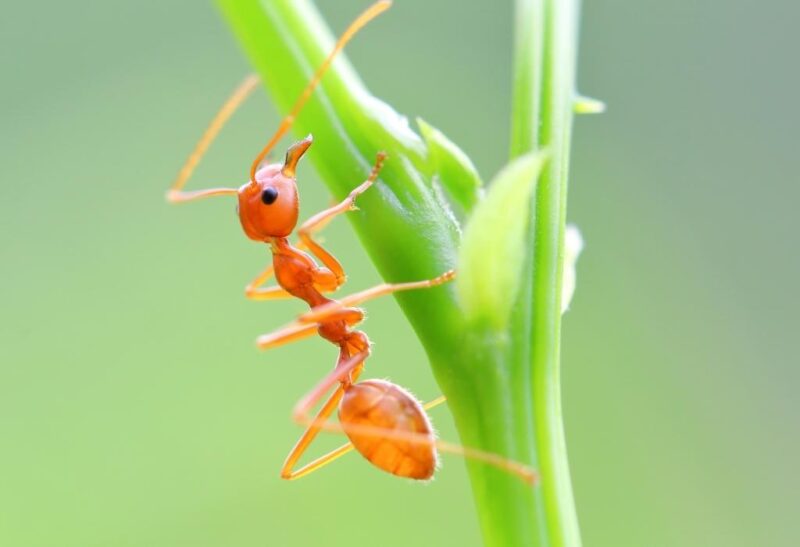Observing ants from a distance, it seems like the world will never run out of them. Ant colonies seem to be everywhere, too.
However, there are, in fact, numerous animals that eat ants: giant anteater, pangolins, aardvarks, house geckos, horned lizards, antlions, fire ants, and jumping spiders are among those who feed on ants as part of their diet.
Interestingly, orangutans, wrens, bears, and humans also eat them occasionally.
But why exactly do they feed on ants? Do these animals find ants nutritious? What can they possibly get from eating ants? These are just some of the questions that this article seeks to answer.
Table of Contents
Which Vitamin Is Present in an Ant?
Ants are rich in vitamin B12, which is known for improving metabolism and the body’s overall cell health. But aside from this vitamin, studies reveal that ants also contain a variety of other macro and micronutrients. This includes calcium, magnesium, iron, and zinc.
Interestingly, ants also have high protein content, as well as antioxidant and antimicrobial properties. Some studies even show high fiber levels in some ant species.
From all this, there’s no doubt that ants are quite nutritious. And as surprising as it seems, even humans can eat ants.
Can Humans Eat Ants?
Humans can eat ants. If you’re worried about accidentally eating ants that were in your food or drink, there’s no need to panic. Ants contain vitamins and minerals that can provide health benefits to humans.
In fact, there are accounts of prehistoric humans eating edible insects and ants as a source of protein. It’s also worth noting that some cultures in Asia, South America, and Africa consider edible ants as a supplement to their diets.
Can Eating Ants Make You Sick?
Eating ants cannot make you sick. However, there are rare instances of infection if you ingest ants that contain parasites. But again, these instances are quite rare. Also, it’s important to highlight that not all ants are edible. Some of them can sting and cause allergic reactions.
12 Animals That Eat Ants
Orangutans

Orangutans are among the few mammals that eat ants. While an orangutan’s regular diet consists of fruits and leaves, they also eat insects they find on trees, like termites and ants.
In the native Malay language, orangutan translates to “man of the forest.” This is a nod to how these friendly primates protect and maintain a healthy rainforest.
- Scientific Name: Pango
- Appearance: Orangutans are distinguishable from other primates because of their long and shaggy reddish-brown fur and large ape-like physique. An orangutan’s face is usually flat and dark gray, with notable cheek flaps as they grow into adulthood. These primates also have longer arms than legs, which helps them navigate through trees in the forest.
- Color: Reddish-brown, dark brown
- Lifespan: 35 to 45 years
- Habitat: Tropical rainforest
- Height: 4-5 feet and 10 inches
- Weight: Up to 165 pounds
- Diet: Fruits, leaves, plant barks, and insects
- Place Of Origin: Island of Borneo, Malaysia, and Indonesia
- Characteristics: Quadrupedal locomotion, arboreal
Aardvark
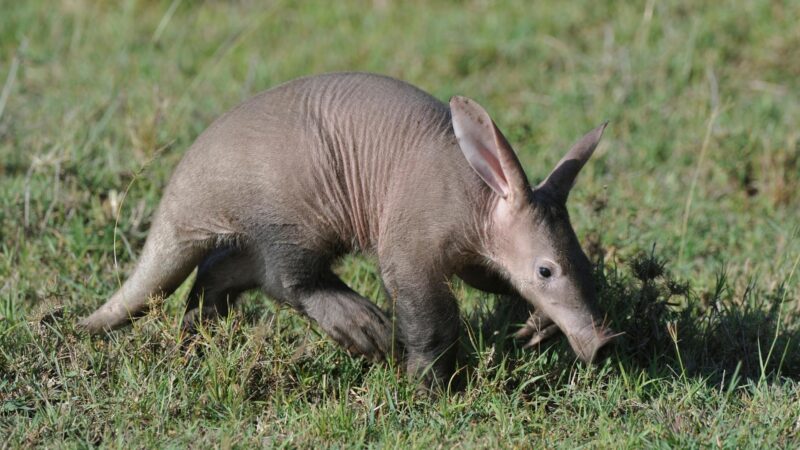
Aardvarks are known to survive a diet that mainly consists of ants and termites. They have strong and sharp claws that help them burrow and destroy ant mounds to survive.
Being nocturnal animals, aardvarks rely on their sharp senses of hearing and smell to hunt for food. They also have long sticky tongues that easily trap ants and termites.
- Scientific Name: Orycteropus afer
- Appearance: Aardvarks are notable for their long, snouted noses, which is why they’re often referred to as earth pigs. They have a rather round stocky body that’s covered in short pale gray fur. They also have long, pointy ears, which help them navigate for food and survival in the dark. Aardvarks also have long and sturdy claws that help them burrow efficiently underground.
- Color: Pale gray, yellowish gray, reddish-brown
- Lifespan: Up to 23 years
- Habitat: deserts, savannas, grasslands
- Height: 3.5 to 4.2 feet
- Weight: 88 to 143 pounds
- Diet: Ants and termites
- Place Of Origin: Africa
- Characteristics: Burrowing, nocturnal
Pangolins
Another animal that regularly feeds on ants is pangolins. Otherwise known as scaly anteaters, these mammals similarly use the sticky saliva on their tongues to catch their food. They also have long, sharp claws that allow them to destroy mounds while hunting. When they feel threatened, pangolins curl into a ball to protect themselves.
- Scientific Name: Manidae
- Appearance: The most notable feature of pangolins is their body that’s mostly covered in sharp scales. These animals have long noses and strong claws that help them navigate through underground burrows with ease. Pangolins also have long scaly tails that help them climb trees.
- Color: Pale gray, yellowish gray, light brown
- Lifespan: Unknown
- Habitat: grasslands, forests
- Height: 3 to 4 feet
- Weight: 60 to 72 pounds
- Diet: Ants and termites
- Place Of Origin: East Asia, Southeast Asia, Africa
- Characteristics: Nocturnal, burrowing, solitary
Wrens
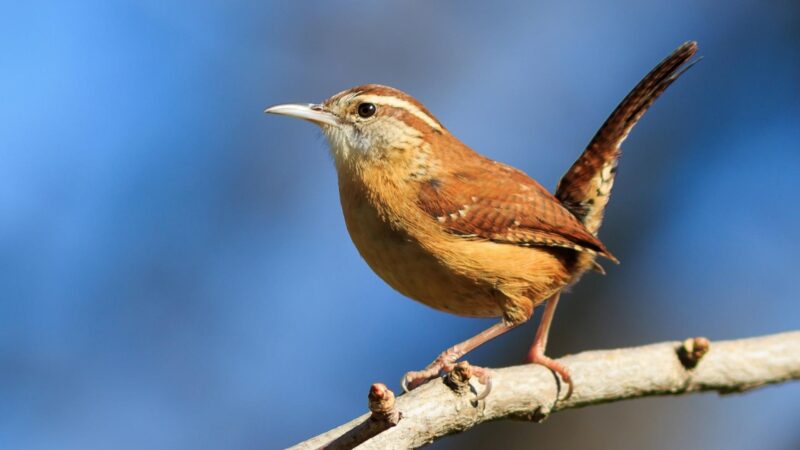
Interestingly, birds like wrens also eat ants. This tiny songbird mainly feeds on insects, worms, and spiders, but they also peck on ants on occasion. This bird is known for its seemingly complicated songs and loud voices – despite its petite size.
- Scientific Name: Troglodytidae
- Appearance: Wrens have small, round bodies covered in brown and white feathers. Most wren species have a white line above their eyes to make it appear like they have long eyebrows. Considering their body shape, wrens have surprisingly long legs and feet.
- Color: Brown, orange-brown, brown, and white
- Lifespan: Up to 7 years
- Habitat: Tropical rainforests, deserts, meadows, wetlands
- Height: 4 to 5 inches
- Weight: Up to 0.5 ounces
- Diet: Insects, spiders, worms
- Place Of Origin: Eurasia, North America, Africa
- Characteristics: Loud, songbird
Giant Anteater
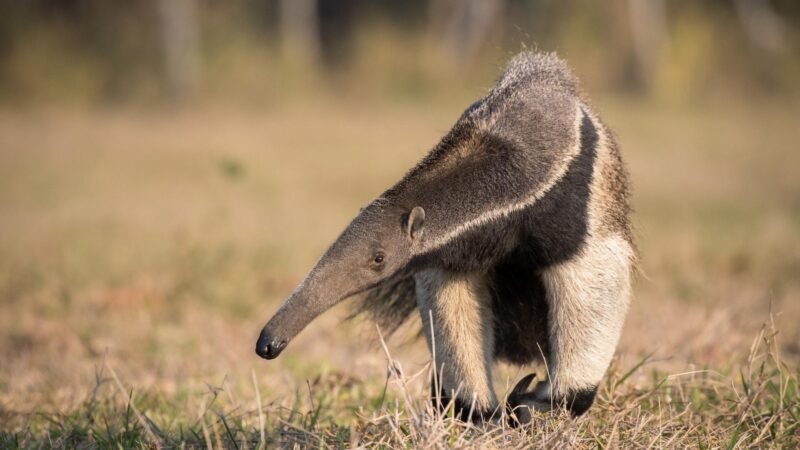
As the name implies, giant anteaters are best known for feeding on ants. Best known for their sticky tongues, it’s interesting to note that an anteater’s tongue can extend up to two feet long. This makes it easy for them to catch and eat ants despite not having any teeth.
- Scientific Name: Myrmecophaga tridactyla
- Appearance: Giant anteaters have coarse fur running throughout their bodies. They have a pair of distinctive stripes from their chest to their back, which makes them easy to distinguish. They also have a long snout that helps amplify their sense of smell.
Giant anteaters have large and powerful claws for digging and searching for food. Interestingly, these animals also have bushy tails, which they use to provide shade on hot days.
- Color: Gray and white, dark gray and white, gray and light brown
- Lifespan: Up to 14 years
- Habitat: Tropical forests, wetlands, grasslands
- Height: 6 to 8 feet
- Weight: 60 to 100 pounds
- Diet: Ants
- Place Of Origin: South America, Central America
- Characteristics: Solitary, nocturnal
Fire Ants
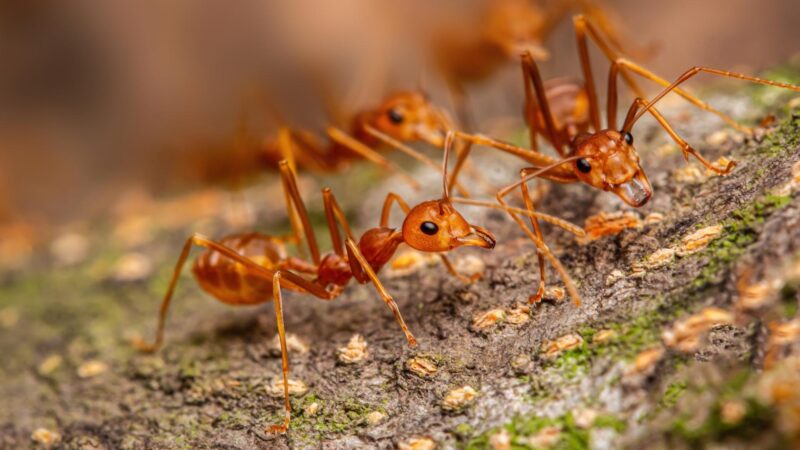
This may come as a surprise, but fire ants eat other ants. These are the larger and more aggressive species of ants and are known for feeding on a variety of insects and spiders. Fire ants are infamous for their bites that can cause allergic reactions. That’s why they are not considered edible.
- Scientific Name: Solenopsis
- Appearance: Fire ants can be easily distinguished from other ants because of their larger and generally reddish bodies. They usually have a reddish-brown head and thorax and a black abdomen.
- Color: Red, reddish-brown, black and red
- Lifespan: 2 to 6 months
- Habitat: Moist fields and meadows
- Height: 0.05 to 0.15 inches
- Weight: 0.003 ounces
- Diet: Insects, worms, ticks, spiders, ants
- Place Of Origin: South America
- Characteristics: Aggressive, intrusive
House Gecko
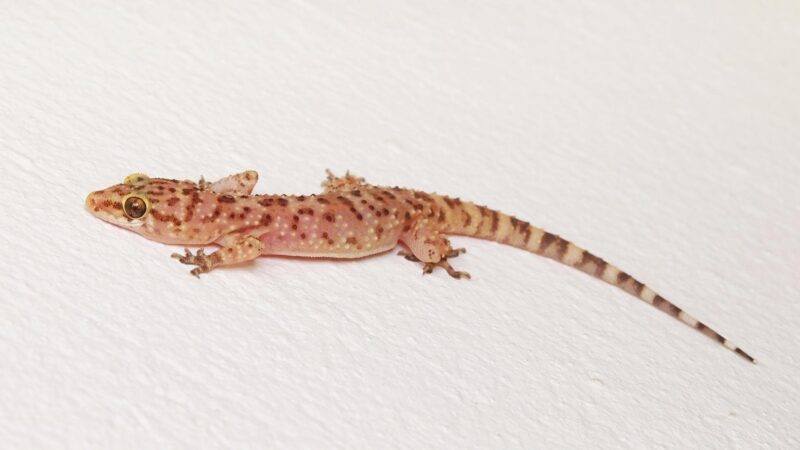
The common house gecko is known to feast on flies and crickets, but it also munches on ants from time to time. These tiny reptiles have long tongues that are incredibly flexible to help catch their prey. Interestingly, the tip of their tongues is also sticky. This makes it easier to trap flighty insects.
- Scientific Name: Hemidactylus frenatus
- Appearance: House geckos have long and slender bodies that grow up to 6 inches. The top of their bodies is covered in small scales of pale pink or light gray with a slight marbling appearance. The bottom of their bodies appears smoother with a dirty white or beige color.
- Color: Light gray, pale pinkish-gray, dark creamy white
- Lifespan: Up to 5 years
- Habitat: Warm and humid areas in human houses
- Height: 3 to 6 inches
- Weight: 0.12 ounces
- Diet: Crickets, flies, insects
- Place Of Origin: South Asia, Southeast Asia
- Characteristics: Non-venomous, non-intrusive
Horned Lizards
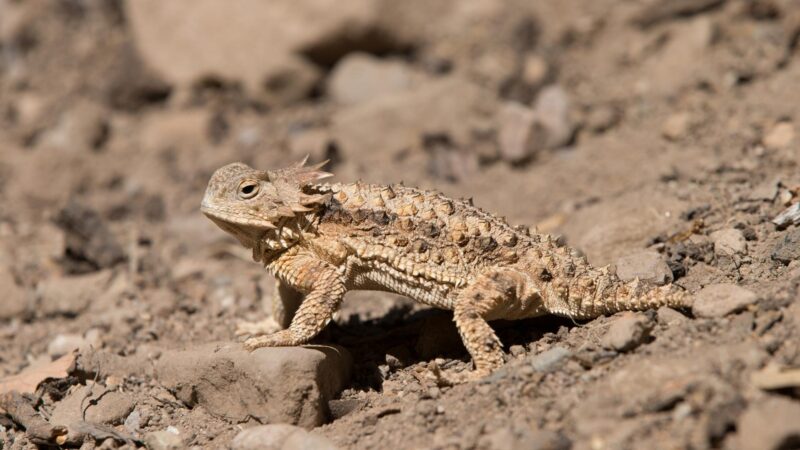
Horned lizards are among the most fascinating creatures to have walked the earth. Like most lizards, they have long, sticky tongues that help them catch their food. However, they have a notable defense mechanism – they can squirt blood from their eyes. Now that’s not something a lot of animals can do.
- Scientific Name: Phrynosoma
- Appearance: Horned lizards have round stocky bodies with short narrow arms and legs. As its name implies, this lizard has scaly spikes all over its body, most notably on the crown of the head, around the body, and in parallel patterns on top of the body.
This tiny reptile is also covered in notable patterns that help it blend with the surrounding environment. The under part of a horned lizard’s body is pale yellowish to creamy white. This part is also made of smoother scales to help these lizards move freely.
- Color: Light brown, light gray, tan
- Lifespan: Up to 5 years
- Habitat: Sandy areas, loam soil areas
- Height: 2.4 to 4 inches
- Weight: 0.89 ounces
- Diet: Spiders, insects, ants
- Place Of Origin: North America, Central America
- Characteristics: Solitary, territorial, burrowing
Antlions
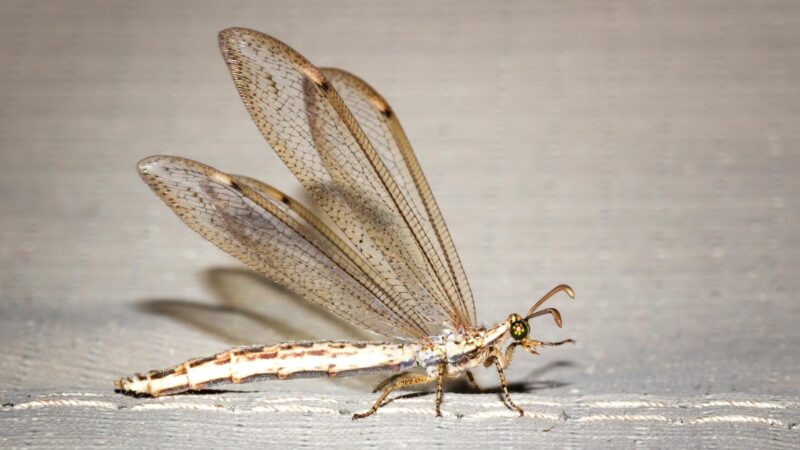
Antlions – particularly the larvae – are known to trap and feast on ants and other small insects. They dig pit-like traps underneath the sand and wait for unsuspecting prey to fall into them. Interestingly, these antlion larvae are nicknamed “doodlebugs” because they draw lines and circles as they burrow underneath the sand.
- Scientific Name: Myrmeleontidae
- Appearance: Antlion larvae have flat yet round bodies with three pairs of tiny legs. The head is likewise flat with a pair of large pincers. Both the head and the body are covered in bristles.
As the antlion grows into adulthood, it develops a long narrow body with four lace-like wings. As adults, antlions have an appearance akin to a damselfly, except that they are black or brown with a curved pair of antennae.
- Color: Black, brown, light brown, black and brown
- Lifespan: Up to 8 weeks
- Habitat: Dunes, sandy forests, riverbanks
- Height: 0.5 to 3 inches
- Weight: Unknown
- Diet: Ants, small insects, pollen
- Place Of Origin: North America
- Characteristics: Sedentary, predatory
Jumping Spider
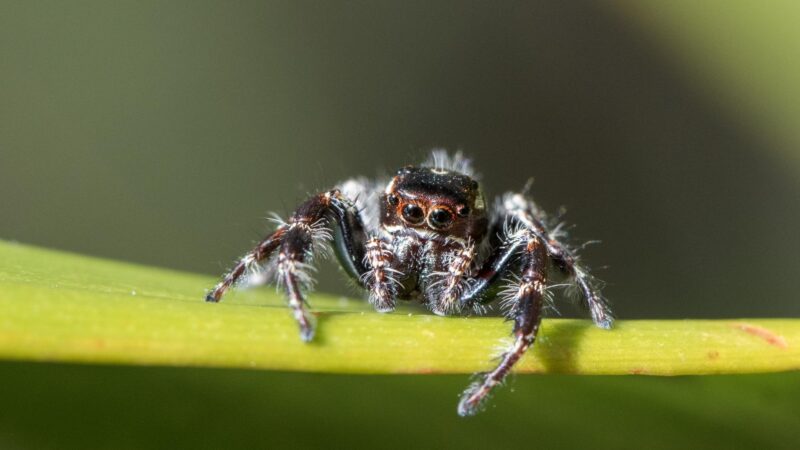
It comes as no surprise that jumping spiders eat ants, although only occasionally. As the name implies, these arachnids are known to pounce upon their target. These movements make them look like they’re dancing, which adds to their charm.
- Scientific Name: Salticidae
- Appearance: Jumping spiders have notable round and plump bodies with eight stubby legs. They have four pairs of eyes – one pair of which is larger than the others and located at the center of the head.
These spiders are also covered in tiny hairs which makes them look fuzzy from a distance. Jumping spiders also have distinct stripe patterns on their legs, which can either be black and white or black and light brown.
- Color: Black, dark brown, dark gray
- Lifespan: 2 to 3 years
- Habitat: Tropical rainforests, grasslands, scrublands
- Height: 0.75 inches
- Weight: 0.0004 to 0.0005 ounces
- Diet: Flies, insects, garden pests
- Place Of Origin: North America, South America, Europe, Australia, Asia, and Africa
- Characteristics: Non-obtrusive, social, inquisitive, non-poisonous, venomous
Bears
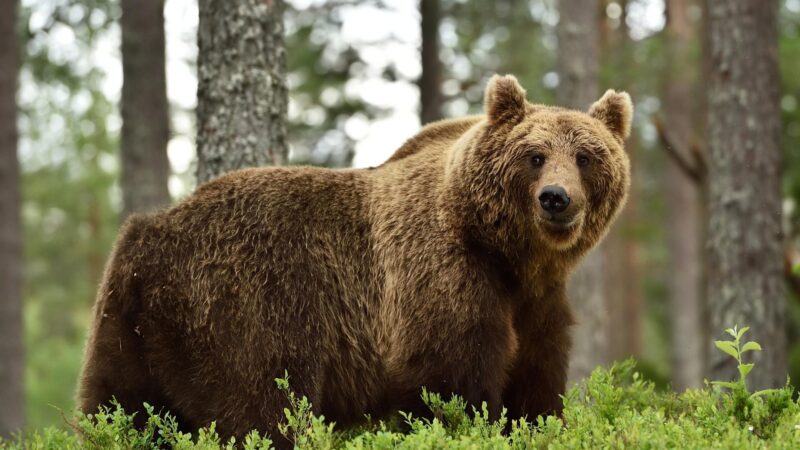
This may come as a surprise, but bears also eat ants sometimes. A bear’s diet is mostly meat from ruminant mammals and fish, but they also get protein from munching on clumps of ants. Particularly the black bear, this mammal uses its powerful claws to tear logs and trap prey with its long and sticky tongue.
- Scientific Name: Ursidae
- Appearance: Bears have plump bodies with short tails and stubby legs and arms. These mammals have a pair of small eyes, a long snout, and a pair of rounded ears sitting at the top of the head. The whole body is also covered in dark shaggy fur, which makes them look less intimidating than they should be.
- Color: Black, brown, dark brown
- Lifespan: Up to 30 years
- Habitat: Forests, mountains, tundra
- Height: Up to 9.8 feet
- Weight: 600 to 1200 pounds
- Diet: Deer, moose, fish, fruits
- Place Of Origin: Europe, Asia, North America
- Characteristics: Solitary, caniform, quadruped
Humans
As previously established, humans can eat ants. It’s a popular exotic street food in the Amazon and some countries in Southeast Asia, where it’s considered a healthy source of vitamins and protein. Ancient civilizations even believed in the healing power of edible ants. So whether cooked or raw, there’s no doubt that humans can safely consume ants.
In conclusion, ants are a nutritious source of vitamins and minerals. Surprisingly, it’s beneficial for a variety of animals – and that includes human beings. It’s also a sustainable resource that keeps animals like giant anteaters, aardvarks, and pangolins from going hungry. With all this information, there’s no denying that you’ll start seeing ants from a different perspective.
List of Sources
Hahn, J., Liesch, P. (2020). Ants. University of Wisconsin Extension.
Reátegui, R. C., et al. (2018). Beetles, ants, wasps, or flies? An ethnobiological study of edible insects among the Awajún Amerindians in Amazonas, Peru. Journal of ethnobiology and ethnomedicine.
Liu, A. J., Li, J., Gómez, M. I. (2020). Factors Influencing Consumption of Edible Insects for Chinese Consumers. Insects.
Alagappan, S., et al. (2021). Nutritional analysis, volatile composition, antimicrobial and antioxidant properties of Australian green ants (Oecophylla smaragdina). Queensland Department of Agriculture and Fisheries.
